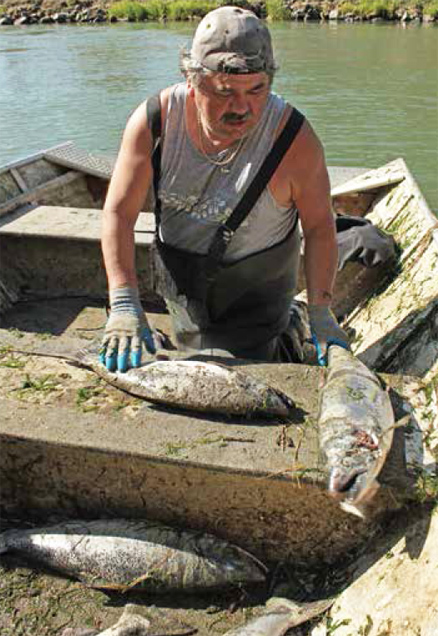Associated Press
LAC-MEGANTIC, Quebec — Everyone missing in the fiery crash of a runaway oil train in Quebec is presumed dead, police told grieving families, bringing the death toll to 50 in Canada’s worst railway catastrophe in almost 150 years.
Meanwhile, attention focused on the CEO of the railway’s parent company, who faced jeers from local residents and blamed the train’s engineer for improperly setting its breaks before the disaster.
Officials said Wednesday evening that 20 bodies had been found in this burned-out town, and 30 people were missing.
“We informed them of the potential loss of their loved ones,” said Quebec police inspector Michel Forget, who came to an afternoon news briefing from a meeting with families of the dead and missing. “You have to understand that it’s a very emotional moment.”
Edward Burkhardt, the head of the train’s U.S.-based parent company blamed the engineer for failing to set the brakes properly before the unmanned Montreal, Maine & Atlantic Railway train hurtled down a seven-mile (11-kilometer) incline, derailed and ignited in the center of Lac-Megantic early Saturday. All but one of its 73 cars was carrying oil, and at least five exploded.
The crash has raised questions about the rapidly growing use of rail to transport oil in North America, especially in the booming North Dakota oil fields and Alberta oil sands far from the sea.
The intensity of the explosions and fire made parts of the devastated town too hot and dangerous to enter and find bodies days after the disaster. Only one body had been formally identified, said Genevieve Guilbault of the coroner’s office, and she described efforts to identify the other remains as “very long and arduous work.”
Burkhardt, president and CEO of the railway’s parent company, Rail World Inc., faced jeers from residents and scorn from Quebec’s premier as he made his first visit to the town since the disaster. He was expected to meet with residents and the mayor Thursday.
Burkhardt said the train’s engineer had been suspended without pay and was under “police control.”
Investigators also had spoken with Burkhardt during his visit, said a police official, Sgt. Benoit Richard. He did not elaborate.
Until Wednesday, the railway company had defended its employees’ actions, but that changed abruptly as Burkhardt singled out the engineer.
“We think he applied some hand brakes, but the question is, did he apply enough of them?” Burkhardt said. “He said he applied 11 hand brakes. We think that’s not true. Initially we believed him, but now we don’t.”
Burkhardt did not name the engineer, though the company had previously identified the employee as Tom Harding of Quebec. Harding has not spoken publicly since the crash.
“He’s not in jail, but police have talked about prosecuting him,” Burkhardt said. “I understand exactly why the police are considering criminal charges … If that’s the case, let the chips fall where they may.”
Investigators are also looking at a fire on the same train just hours before the disaster. A fire official has said the train’s power was shut down as standard operating procedure, meaning the train’s air brakes would have been disabled. In that case, hand brakes on individual train cars would have been needed.
The derailment is Canada’s worst railway disaster since a train plunged into a Quebec river in 1864, killing 99.
Quebec police have said they were pursuing a wide-ranging criminal investigation, extending to the possibilities of criminal negligence and some sort of tampering with the train before the crash. The heart of the town’s central business district is being treated as a crime scene and remained cordoned off by police tape.
At a news conference shortly before Burkhardt’s arrival, Quebec Premier Pauline Marois faulted his company’s response.
“We have realized there are serious gaps from the railway company from not having been there and not communicating with the public,” Marois said. She depicted Burkhardt’s attitude as “deplorable” and “unacceptable.”
Burkhardt, who arrived in town with a police escort, said he had delayed his visit in order to deal with the crisis from his office in Chicago, saying he was better able to communicate from there with insurers and officials in different places.
“I understand the extreme anger,” he said. “We owe an abject apology to the people in this town.”
In an exchange with reporters, Burkhardt defended the practice of leaving trains unmanned, as was the case when the train rolled away. Canadian transportation department officials have said there are no regulations against it.
“For the future we, and I think probably the rest of the industry, aren’t going to be leaving these trains unmanned,” Burkhardt said. “We’ll take the lead with that. I think the rest of the industry is going to follow.”
Among the residents looking on as Burkhardt spoke was Raymond Lafontaine, who is believed to have lost a son, two daughters-in-law and an employee in the disaster.
“That man, I feel pity for him,” Lafontaine said. “Maybe some who know him properly may think he’s the greatest guy in the world, but with his actions, the wait that took place, it doesn’t look good.”
The disaster forced about 2,000 of the town’s 6,000 residents from their homes, but most have been allowed to return.










